Api编写
1> api常用的数据的格式有json和xml这两种。
2> 下面开始讲解不同的数据格式使用的方式
1->JSON 数据直接输出.
调用 ServeJSON 之后,会设置 content-type 为 application/json,然后同时把数据进行 JSON 序列化输出
2->XML 数据直接输出
调用 ServeXML 之后,会设置 content-type 为 application/xml,同时数据会进行 XML 序列化输出
3->jsonp 调用
调用 ServeJSONP 之后,会设置 content-type 为 application/javascript,然后同时把数据进行 JSON 序列化,然后根据请求的 callback 参数设置 jsonp 输出。
4->字典表格式的数据
以键值对的形式
3> 新建一个api.go的控制器,编写业务逻辑。具体代码如下:
package controllers
import (
"github.com/astaxie/beego"
)
//Api页面
type ApiController struct {
beego.Controller
}
func (c *ApiController) Get() {
c.TplName="api.html"
}
//JSON格式的数据
type ApiJsonController struct {
beego.Controller
}
func (c *ApiJsonController) Get() {
//注意此处的json,必须是json
c.Data["json"] = "ABCDEFG"
c.ServeJSON()
}
//XML格式的数据
type ApiXMLController struct {
beego.Controller
}
func (c *ApiXMLController) Get() {
//注意此处的xml,必须是xml
c.Data["xml"] = "BCDEFGH"
c.ServeXML()
}
//Jsonp格式的数据
type ApiJsonpController struct {
beego.Controller
}
func (c *ApiJsonpController) Get() {
//注意此处的jsonp,必须是jsonp
c.Data["jsonp"] = "CDEFGHI"
c.ServeJSONP()
}
//字典表格式的数据
type ApiDictionaryController struct {
beego.Controller
}
func (c *ApiDictionaryController) Get() {
c.Data["json"]=map[string]interface{}{"name":"ABC123","rows":45,"flag":true};
c.ServeJSON()
}
//带参数的表格式的数据
type ApiParamsController struct {
beego.Controller
}
func (c *ApiParamsController) Get() {
search:=c.GetString("name")
c.Data["json"]=map[string]interface{}{"name":search,"rows":45,"flag":false};
c.ServeJSON()
}
4> 新建一个api.html页面,作为测试页面使用
<!DOCTYPE html>
<html>
<head>
<title>首页 - 用户列表页面</title>
<link rel="shortcut icon" href="/static/img/favicon.png" />
<link rel="stylesheet" href="/static/bootstrap/css/bootstrap.css"/>
<script type="text/javascript" src="/static/js/jquery-2.1.1.min.js"></script>
<script type="text/javascript" src="/static/bootstrap/js/bootstrap.min.js"></script>
</head>
<body>
<div class="container">
<!--请求得到Json数据-->
<div style="100%;height:50px;">
<button onclick="getjson()" class="btn btn-primary">得到Json</button>
<label id="txtjson"></label>
</div>
<!--请求得到Xml数据-->
<div style="100%;height:50px;">
<button onclick="getxml()" class="btn btn-primary">得到Xml</button>
<label id="txtxml"></label>
</div>
<!--请求得到Jsonp数据-->
<div style="100%;height:50px;">
<button onclick="getjsonp()" class="btn btn-primary">得到Jsonp</button>
<label id="txtjsonp"></label>
</div>
<!--请求得到字典数据-->
<div style="100%;height:50px;">
<button onclick="getdictionary()" class="btn btn-primary">得到字典</button>
<label id="txtdictionary"></label>
</div>
<!--请求得到字典数据-->
<div style="100%;height:50px;">
<input type="text" id="search" placeholder="请输入参数"/>
<button onclick="getparams()" class="btn btn-primary">得到参数</button>
<label id="txtparams"></label>
</div>
</div>
<!--JS部分-->
<script type="text/javascript">
//得到Json
function getjson(){
$.ajax({
type:'get',
url:'/api/GetJson',
dataType:'json',//此处的是json数据的格式
data:{},
success:function(result){
console.log('获取json的数据')
console.log(result)
$("#txtjson").html("json的结果:"+result);
}
})
}
//得到Xml
function getxml(){
$.ajax({
type:'get',
url:'/api/GetXml',
dataType:'xml',//此处的是xml数据的格式
data:{},
success:function(result){
console.log('获取xml的数据')
console.log(result)
$("#txtxml").html("xml的结果:"+$(result).text());
}
})
}
//得到jsonp
function getjsonp(){
$.ajax({
type:'get',
url:'/api/GetJsonp',
dataType:'jsonp',//此处的是jsonp数据的格式
data:{},
success:function(result){
console.log('获取jsonp的数据')
console.log(result)
$("#txtjsonp").html("jsonp的结果:"+result);
}
})
}
//得到字典
function getdictionary(){
$.ajax({
type:'get',
url:'/api/GetDictionary',//此处的是json数据的格式
data:{},
success:function(result){
console.log('获取字典的数据')
console.log(result)
$("#txtdictionary").html("字典的结果:"+result.name+","+result.rows+","+result.flag);
}
})
}
//得到参数
function getparams(){
$.ajax({
type:'get',
url:'/api/GetParams',//此处的是json数据的格式
data:{
"name":$("#search").val()
},
success:function(result){
console.log('获取参数的数据')
console.log(result.json)
$("#txtparams").html("获取参数结果:"+result.name+","+result.rows+","+result.flag);
}
})
}
</script>
</body>
</html>
5> 在路由器中添加路由,编译运行,修订错误
package routers
import (
"secondweb/controllers"
"github.com/astaxie/beego"
)
func init() {
beego.Router("/", &controllers.MainController{})
beego.Router("/Home/PageData", &controllers.UserController{})
beego.Router("/Home/PageNextData", &controllers.YonghuController{})
beego.Router("/Home/Index", &controllers.PageController{})
beego.Router("/Home/EasyUI", &controllers.EasyUIController{})
beego.Router("/Home/EasyUIData", &controllers.EasyUIDataController{})
beego.Router("/Home/FileOpt", &controllers.FileOptUploadController{})
beego.Router("/Home/FileDown", &controllers.FileOptDownloadController{})
beego.Router("/Home/FileRead", &controllers.ReadController{})
beego.Router("/Home/FileWrite", &controllers.WriteController{})
beego.Router("/Home/FileCreate", &controllers.CreateController{})
beego.Router("/Home/FileDelete", &controllers.DeleteController{})
//Api接口部分
beego.Router("/api/Html", &controllers.ApiController{})
beego.Router("/api/GetJson", &controllers.ApiJsonController{})
beego.Router("/api/GetXml", &controllers.ApiXMLController{})
beego.Router("/api/GetJsonp", &controllers.ApiJsonpController{})
beego.Router("/api/GetDictionary", &controllers.ApiDictionaryController{})
beego.Router("/api/GetParams", &controllers.ApiParamsController{})
}
6> 运行效果
1->运行的页面如下:
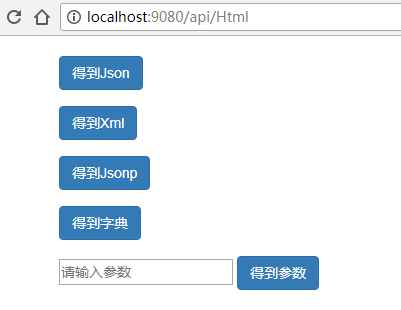
2->调用json的接口,得到json格式的数据
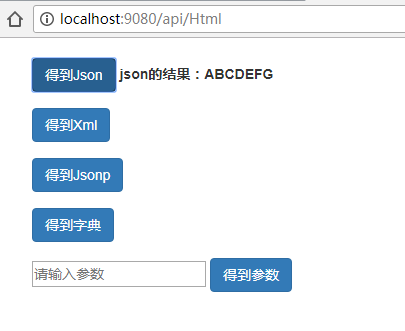
3->请求得到xml格式的数据,得到xml格式的数据
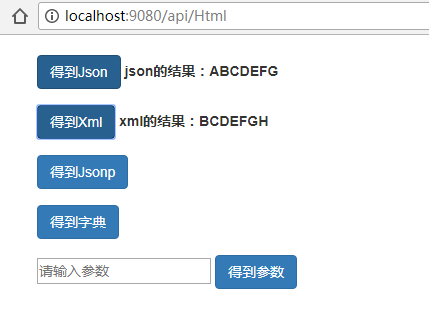
4->请求jsonp格式的数据,得到jsonp格式的数据
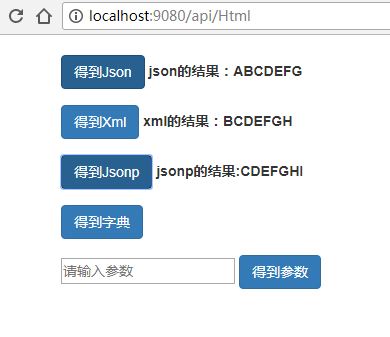
5->请求得到字典表格式的数据,得到键值对形式的数据
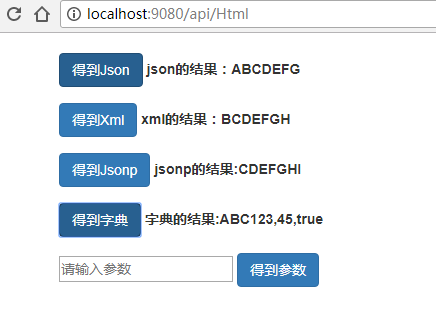
6->请求参数的数据,将参数以及其他的数据返回
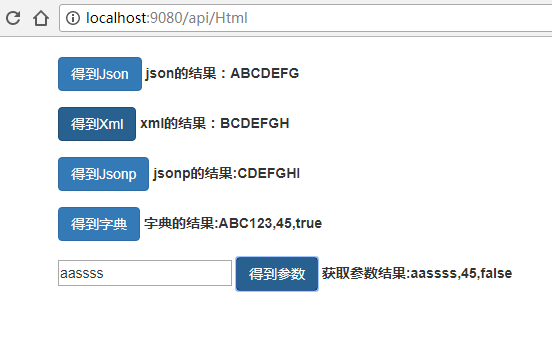
7> 下一章讲session的运用